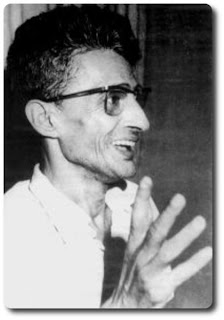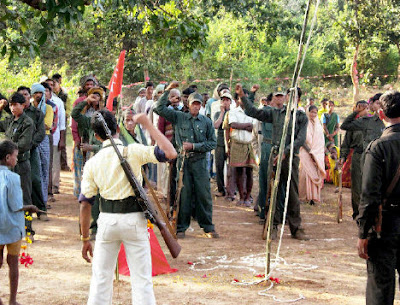 |
| Young Marx |
One reason why Karl Marx attained immortality whereas Socialists before him could not is because he searched for the root of the problem while others were engaged with offshoot branches. He studied history completely from a different perspective and thought which helped him to understand the flow of human civilization. He like Lenin studied voraciously, was regular visitor to the library at Manchester while his stay in England. His Notes on Indian History which contains important events of India from the year 664-1858 is a great read especially if one is trying to understand the “flow”. He took great care to arrest the Santhal Rebellion in his notes, and here is what he says-
“1855-1856. Outbreak of the Santals, a half-savage tribe, in the Rajmahal Hills in Bengal; put down, after seven months' guerrilla warfare, in February 1856.”
Well, one can obviously raise eyebrows over his choice of words, but then again Marx actually prepared those notes following the daily mails which of course contained British interpretation. In this note he occasionally uses the word “dog” in varied sense, such as, “Aurangazeb allowed the “dogs””, i.e, “the company”, and again “in the defile, the natives shot the “British dogs”. So as you can see this was a very personal note where he noted everything down not caring for the fact that it would be published one day.
Although, Marx’s writing style is not the subject of this article; just I thought I could introduce the topic this way! The causes of the Santhal Rebellion more or less we are aware of. But just as a revision, I will discuss it briefly again. We started with Marx so I will try to explain in his way and hopefully that won’t be an unscientific explanation.
Capitalism creates Imperialism, it is not very hard to understand, if you have a doubt you can have a look at the present world order. Now the machinery called, “Imperialism” creates a great social and financial difference between the conquered and conqueror. This is also not hard to understand I guess. A chain of blood sucking parasite is created by this where the end result is always a plight for the poorest of the poor. The British controlled India; they by all means ensured that great profit from India could be drawn. The Company established the Jamindari system through which they got the revenue as taxes. Not necessarily the Jamindars would hail from a noble family of high class but in practice he has to be a ruthless extortionist who can squeeze his subjects and make them pay taxes. As a matter of fact the peasants suffered most due to this and that is why we could see a number of peasant revolt big or small came up during this period, even before Santhal rebellion.
From the period 1765-1857 a number of uprising took place where peasants took to arms. In fact the condition of the peasants was much worse than the time of the Mughals. There are only few recorded incidents of revolts in the Mughal history, but in this period i.e. 1765- 1857 the examples are many. Also under the new system the taxes were to be paid in cash, which in turn gave rise to a number of middlemen, money lenders, thikadars who were the best of fiend. Thus occurred the Paharia uprising (1756-73), the Chuar Rebellion (1795-1800), uprisings in Chotanagpur (1820), Kol and Bhumij insurrection, and many more, all these took place before the Santhal Rebellion.[i] Also we get to see in this period infamous revenue collectors like Debi Singh who made the life of the Jamindars miserable.
So in this long hierarchy of revenue collection each one tried to extort the other and the people at bottom suffered the most. As a matter of fact the Santhals did not have much complain or grievance against the British as they had against the money lenders, and other operatives of the Jamindar. The latter group had made their life miserable and eventually they spited out their anger against them.
The British Government was actually surprised and shocked by the events that followed the Santhal Rebellion. In some ways the revolt had displayed the extreme acts of tribal passion and also had seen extreme measures of suppression. An investigation was done under Sir Ashley Eden and what came up next were the Acts of XXXVII of 1855 and Act X of 1857. Through these acts a separate zone was created for the Santhals named as, “Santhal Pargana” which is where the Santhals lived. The Act was gave special status to the zone of Santhal Pargana, it became independent of the jurisdiction of other regular courts.[ii] The Santhal Majhi-pargana system was accepted, the village headman, “Majhi” was vested the power to collect taxes and look into matters relating to the Santhals.
However the root of the problem did not go, the Santhals still needed to pay exorbitant rents for the land. The rent of the lands was increased through the Rent Act of 1859, and the revised rents became a burden for the Santhals again. Unable to bear the pressure of rent the Santhals once more assembled to launch a new movement, The Kherwar Movement. The starter of the Kherwar Movement, Bhagirath Manjhi explained the philosophy of the revolt by saying, “No human being created the Earth, no human being has ploughed our land but we, no human being but we have the right to share the produce.”[iii]
This massive movement which kicked off in 1874 received incredible support from Santhals of all places. Villages after villages resounded on the sound of “Kherwar”, thousands of Santhals voiced for their legitimate right. The much cherished Santhal dream of “Santhal Raj” rekindled and the passion behind it was no way less than the fervor of Jews about “the Promised Land”. A land for the Santhals, where the Santhals would rule, Santhals would plough, and Santhals would reign supreme. A sort of cultural refreshment went as well, the Santhals were reminded by the Majhi’s to maintain pure thoughts and perform pure actions. Somehow the revolt turned violent, a number of arrests were made, including of the leader Bhagirath, and after enough arrests were made the revolt and the passion slowly subsided, but the idea did not.
Bhagirath the prime mover of the “Kherwar Movement” believed and endorsed the idea that a supernatural force was necessary to bring independence for the Santhals. In the late 1920’s a similar dream of Santhal liberation was rekindled by yet another hero, Jitu Santhal. Jitu Santhal of Malda district launched a widespread movement which included hundreds of landless and shared-cropper Santhals to fight for land. Santhals are an agricultural community and land occupies a central place in the Santhal way of life. The stage of revolt was set because of injustice done by the Jamindars and their operatives to snatch the land of the Santhals. The reasons behind the expropriation of land are unbelievable. The local newspaper of that time tells that a Santhal lost his land because he could not pay some ten or twelve rupees borrowed from the money lender. There were also instances where a Santhal lost land because he burrowed salt from the money lender which he could not return. In this way around 25,000 acres of land from the Santhals were confiscated by the money lenders, touts or Jamindars![iv]
Jitu Santal was a great admirer of Gandhiji and “Gandhi Raj”, although his understanding of Gandhi Raj was markedly different of what Gandhi might ever think of. This simple man dreamt that in Gandhi Raj there would be no money lenders, no Jamindars and the original tillers of the soil would retain their land. Hundreds and thousands of Santhals believed him and his words. Jitu got his strength from the local Hindu Mahasabha, a guru from the sabha brain washed him to undertake a reformation inside his community, not to eat forbidden meat, worshipping of Hindu gods, and conversion of Santhals to Hinduism. Jitu diligently followed his master and never for once understood that he was being used as a pawn in communal war game. In October 1932 the Jamindar of Kotwali demanded two-third crops from the Santhals. Following Jitu’s command the Santhals refused to offer and a clash broke out among the Jamindar’s men and the Santhals. Police rushed to the spot to quell the situation, after the clash the Santhals were heartbroken to find that the police actually took the Jamindar’s side.[v] The police protected the Capitalists as the Proletariats suffered. Finally in December 1932, Jitu Santal and six of his comrades died while confronting the police in Adina Mosque.
Jitu’s effort for religious and cultural reformation did not uplift the Santhals in the eyes of the local bhadralok (gentleman), neither they had any sympathy for Jitu or for his movement. In fact the prominent member of the local Mahasbha vehemently supported the suppression of Jitu’s revolt, which earned him Government accolades. Jitu failed, his efforts stumbled but his cause did not, another major upheaval was in the waiting. The flavor, theme and direction of this new movement were markedly different from all.
Perhaps it will be proper to introduce this new movement through the words of its founder; he will give you the exact political scenario, this was written by him a year before he died in captivity, his name is Charu Majumdar!
 |
| Charu Majumdar |
The social system that exists in India is semi-feudal and semi-colonial. So the democratic revolution in this country means agrarian revolution. All the problems of India are related to this one task. On this question of agrarian revolution there has been difference of opinion in Marxist circles from the beginning of this century and among Marxists the struggle between the two policies-the one revolutionary and the other counter-revolutionary-continues. The Mensheviks side-tracked the question of State power and searched for a solution in municipalization. Lenin declared a crusade against it and said that it was not possible to solve the problem by side-tracking the question of State power. He showed that however progressive the legislation framed by one might be, the present State structure could not implement it. The condition of the peasant will remain the same. That was why he said that only the democratic State of workers and peasants, led by the working class, could solve this problem. Only the other day even the Soviet Party writer, Yudin, while criticizing Nehru's Basic Approach, said that Nehru had not till then been able to solve the peasant problem. He challenged Nehru to show, in practice, how this problem could be solved in a peaceful way and added that Nehru would fail to do so. History has proved that, far from solving this problem, Nehru was not able even to bring about an iota of change.
Talking about agrarian revolution who could be greater comrades than the Santhals, I have written over 1500 words to explain this. I have highlighted a particular line in this paragraph just to draw attention to the very essence of Marxism.
Naxalbari, an area populated mostly by tribals, Santhals, Oraons, Mundas, Rajbanshis and others was the perfect place to start the “Spring Thunder”. The landlords exploited the peasants, quarreled over payment wages, refused to return mortgaged lands; in a nutshell showed all the signs for which Marxist revolution can be called for. As a matter of fact although the British packed out of India, the parasites those were created in their regime were still thriving. When the United Front Government came to power in Bengal the landholders developed the fear that their lands would be taken away and distributed. Fearing this they started large scale eviction of shared croppers which invited further trouble.
With the coming of United Front Government the peasants had hoped for a change, they expected that lands would be taken away from the Jamindars and distributed among the landless and shared croppers. But that did not happen, atleast in that course of time. Frustrated by the inactivity of the Government Charu Majumdar, Kanu Sanyal and Jangal Santhal, started mobilizing these landless peasants for a revolution. The goal was to distribute land among everyone, no one should be landless, “land belongs to the tillers” was the slogan. Women were also included in the party, there were secret meetings convened at night. The plan was read, the theories were shared the homework for Revolution was done.
| Kanu Sanyal |
In May 25th, 1967 clash took place between the peasantry and the police, eleven peasants were killed, one local police officer was shot at the chest by an arrow, legends say it was fired by a woman. Arrests were made in the following day, many were taken into custody, and police retaliated ruthlessly. But with the rising number of police atrocities more peasants prepared themselves for sacrifice. By the end of June the CPIM lashed out against the Naxalites, they were termed as anarchists, anti-social, anti-institution etc. Finally in May 1969 the CPIML was formed, a year ago Kanu Sanyal had made it clear that the aim of the struggle is, “not for land but for the state power.”[vi] However, the Government was successful to curb the revolution by iron hand, both Kanu Sanyal and Jangal Santhal were arrested, and Charu Majumdar died in police custody in 1971. Indira Gandhi tackled the Naxals with a heavy hand there were 1400 arrests in Andhra Pradesh, 2000 in Bihar, 4000 in West Bengal and 2000 in Kerala. Several of the Maoists leaders were killed or punished in police custody.[vii]
Even after the Naxalbari incidence in 1967 the spirit of the revolution has not died, since the reasons for the Revolution have lived throughout changing times. In this 45 years India has changed a lot but the condition of the first immigrants to India have not changed substantially. It seems that our policy makers never understood or tried to understand the tribals. Otherwise even after six decades of Independence the situation of the tribals living in forest or in the valley did not alter. The forest which is mother to the tribals has been taken away from them. Rigid forest laws have reduced accessibility of the tribals to the forest, the tough laws have made it difficult to collect fire woods and other things of basic necessity like gum,resins, leaves, flowers, honey etc from the forest. I wonder whether planners know that in their country there are some tribes who have not crossed the stage of food gatherers. The Sabars for example, for the harsh laws they cannot even go to forest and hunt animals for food, and they cannot cultivate either! And even if they could who would provide them with land?
 |
| Communist Party of India (Maoist) cadre celebrate the founding day of their guerrilla wing, the People’s Liberation Guerilla Army, near Chainpur in Palamu district, Jharkhand, on December 8. |
Take a look at the Maoist infected districts of Bankura, Puruliya and Midnapore, the percentage of tribal population here is 10.43, 18.98, and 8.4. Electricity has reached only 19.03 percent of tribal homes as against 37.45 of the state population. In some parts of these districts people still depend on river and canal for drinking water. [viii]If we have a look at Andhra Pradesh another Maoist inflicted state we will find why it provides a thriving atmosphere. Mahabobnagar, Medak, Nizamabad, Karimnagar, in all these districts of AP where Maoist has strong presence, the level of poverty is quite large. In fact the total literacy rate (male and female) among tribals in these districts are 25.76, 28.08, 30.71, and 34.23! And this is all after six decades of Indian Independence!
It is understandable though that the Maoists had used the tribals as pawns in the game of class struggle, the urge for the local needs of the tribals were diverted to fight out the cause of Communists. In fact they would not have found better comrades than simple, illiterate tribals. One reason why I think Communism will fail like any other institution is that they ignore the question of individual identity. The aim of the tribals is not to alter the state power, but only to obtain the basic amenities that a human is entitled to. Having said all these, I also feel to say that identities can be multiple; among all other cherished identities of the tribals the greatest perhaps is “struggle”, as of now struggle has become their habit.
Photo Courtesy: The Hindu and Wikipedia.
References:
[i] An Advanced History of Modern India, By Sailendra Nath Sen
[ii] Jinnah: man of destiny, By Prakash Almeida
[iii] An Advanced History of Modern India, By Sailendra Nath Sen
[iv] Census 1951, West Bengal District Handbook, Malda, Ed. A Mitra, New Delhi 1954
[v] Changing profile of a Bengal district Malda, 1932-1953, By Ashim Kumar Sarkar
[vi] Report on the Peasant Movement in the Terai Region ,KANU SANYAL
[vii] Indian Defence Review, By Bharat Verma
[viii] Development Ethics, By Prasenjit Maiti
Source: http://sumitsoren1983.blogspot.com/2012/03/tale-of-santhals-story-of-struggle.html*************************************************************************************


0 comments:
Post a Comment